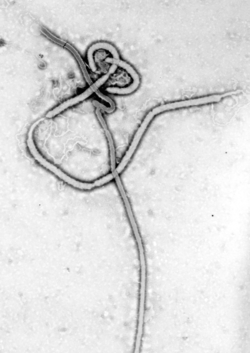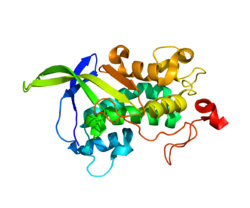Ebola virus
Ebola virus or Ebola virus disease (EVD), often shortened to Ebola, is a very dangerous virus. It belongs to the family Filoviridae. Four different types of Ebola virus can cause a severe disease which is often fatal. Ebola infection causes hemorrhagic fever which starts suddenly. "Hemorrhagic" means that the victim will bleed a lot, inside and outside of their body. The virus attacks almost every organ and tissue of the human body, causing multiple organs to fail at once. Out of every 100 people who get Ebola, on average 25 to 90 die.
| Ebola virus disease | |
|---|---|
| Classification and external resources | |
 Electron microscope picture of the Ebola virus | |
| ICD-10 | A98.4 |
| ICD-9 | 065.8 |
| DiseasesDB | 18043 |
| MedlinePlus | 001339 |
| eMedicine | med/626 |
| MeSH | D019142 |
The virus was first found in Sudan. It is mostly found in Africa, with very few cases in Europe and the United States.[1]
Transmission
The Ebola virus that makes people sick lives in the blood and other liquids and organs in some kinds of non-human animals without killing them. Scientists think the animals it lives in are mainly some kinds of monkeys or fruit bats. When people touch animals that have the virus, or secretions that came out of those animals, they can get sick.[2]
Ebola cannot be caught through the air, or by being near sick people.[3] The virus can only go from liquids into people's bodies. This means Ebola can be caught by touching a sick person's blood, saliva, mucus, semen, diarrhea, vomit, or other fluids that come out of a sick person's body.
If a person does not die from the disease, he can still give other people the infection by having sex for nearly another two months after they stop being sick. This is because the virus can still be in the man's semen after a long time.
1. Once the virus enters the human body via mucosal surfaces, abrasions or injuries in the skin or by direct parental transmission, it fuses with the cells lining the respiratory tract, eyes, or body cavities.
2. It invades the macrophages and dendritic immune cells and releases its genetic content. The cell explosion triggers the secretion of proinflammatory cytokines initiating a ‘cytokine storm’. The genetic material takes over the cell machinery to replicate itself; new copies of the virus are formed and released into the system.
3. The virus then, goes on to attack spleen, kidneys and even the brain. The blood vessels leak blood and fluid into the surrounding tissues. This atypical clotting and bleeding at the same time manifests externally in the form of rashes.
4. The virus causes the shutdown of other vital organs such as liver and lungs too. In fact, it is able to invade almost all human cells through different attachment mechanisms for each cell type (except for lymphocytes). The very cells that are meant to fight infection are used as carriers to spread infection to other body parts
5. It has been found that the ebola-infected cells do not undergo normal apoptosis, but exhibit vacuolization and signs of necrosis.
Symptoms
The symptoms of Ebola disease can develop between 2 to 21 days after a person is infected with the virus.[4] When people get Ebola, the first symptoms may look like other diseases. People may develop "dry" symptoms such as fever, fatigue, weakness, sore throat, joint pain and headache.[4] Sometimes, people think they may have malaria or typhoid fever.[4]
Eventually, individuals get much sicker and experience "wet" symptoms of nausea, vomiting, diarrhea, and belly pain.[5] They may also start to have unexplained bleeding inside and outside the body which can include having blood in the stool, blood in vomit.[4]As the disease progresses, people can go into shock from excess fluid loss which which mean low blood pressure, fast pulse (heart rate), and low blood circulation to the body leading to organ failure.[4]
Treatment
Currently there are two medications approved by the United States Food and Drug Administration (FDA) to treat Ebola Disease: Inmazeb and Ebanga.[4] These medications are made up of monoclonal antibodies.[4] Monoclonal antibodies are a type of protein that are made in the lab. When these medications are used to treat Ebola, they help the body's natural defense system to stop the virus from multiplying in the body.[4]
People with Ebola also need supportive care to relieve symptoms. Lots of fluid and electrolytes are given to replace the fluids lost from diarrhea, vomiting, and bleeding. Fluid can be given by mouth or through an IV which is a special tube that goes into veins the arm. This process of giving fluid back into the body is called fluid replacement therapy. It is also important to give blood transfusions and medicine in the case of low blood pressure which is a complication of fluid loss.Closing </ref> missing for <ref> tag
Many Ebola vaccine candidates had been developed in the decade prior to the West African Ebola epidemic in 2014, but none had yet been approved for use in humans. The Ebola Zaire vaccine also known by its brand name ERVEBO was the first vaccine approved by the FDA in December 2019.[6][7] The vaccine helps to protect against the Zaire Ebola virus, one of the virus types that causes deadly Ebola Disease.[8] ERVEBO is a single dose vaccine and is safe for individuals aged 12 months and older who at risk of infection.[9] Although the vaccine has been given to pregnant and breastfeeding women in past outbreaks, the vaccine has not been approved for these specific groups.[10] Several countries in Africa have successfully used the vaccine since it was approved including Zambia, Burundi, Ghana, and the Democratic Republic of Congo.
Another approved vaccine is Zabdeno / Mvabea. This vaccine is a combination vaccine also used against the Zaire Ebola virus.[11]
Research
World Community Grid is a computing project that is seeking possible drug treatments. People donate the spare time on their computers to the project.
Ebola Virus Media
Phylogenetic tree comparing ebolaviruses and marburgviruses. Numbers indicate percent confidence of branches.
Reference
| Wikimedia Commons has media related to Lua error in Module:Commons_link at line 62: attempt to index field 'wikibase' (a nil value).. |
- ↑ Kevin J. Olival et al. (2013). "Ebola virus antibodies in fruit bats, Bangladesh". Emerging Infectious Disease. CDC. 19 (2): 270–273. doi:10.3201/eid1902.120524. ISSN 1080-6040. PMC 3559038. PMID 23343532. Archived from the original on 2014-07-14. Retrieved 2014-08-12.
{{cite journal}}: CS1 maint: uses authors parameter (link) - ↑ "Ebola virus disease Fact sheet N°103". World Health Organization. March 2014. Retrieved April 12, 2014.
- ↑ "2014 Ebola virus disease (EVD) outbreak in West Africa". WHO. April 21, 2014. Retrieved August 3, 2014.
- ↑ 4.0 4.1 4.2 4.3 4.4 4.5 4.6 4.7 CDC (2024-07-18). "Signs and Symptoms of Ebola Disease". Ebola. Retrieved 2024-10-31.
- ↑ Chappell, Bradley (2018), "Abdominal Pain, Nausea, Vomiting, and Diarrhea", Urgent Care Medicine Secrets, Elsevier, pp. 23–28, ISBN 978-0-323-46215-0, retrieved 2024-10-31
- ↑ "Ebola virus disease: Vaccines". www.who.int. Retrieved 2024-10-31.
- ↑ "U.S. FDA Approves Merck's ERVEBO® (Ebola Zaire Vaccine, Live) for Use in Children 12 Months of Age and Older". Merck.com. Retrieved 2024-10-30.
- ↑ Woolsey, Courtney; Geisbert, Thomas W. (2021-12-09). "Current state of Ebola virus vaccines: A snapshot". PLOS Pathogens. 17 (12): e1010078. doi:10.1371/journal.ppat.1010078. ISSN 1553-7374. PMC 8659338. PMID 34882741.
{{cite journal}}: CS1 maint: PMC format (link) - ↑ CDC (2024-08-12). "Ebola Vaccine Product Information". Ebola. Retrieved 2024-10-31.
- ↑ "Ebola virus disease: Vaccines". www.who.int. Retrieved 2024-10-31.
- ↑ "Zabdeno | European Medicines Agency (EMA)". www.ema.europa.eu. 2020-07-23. Retrieved 2024-10-31.




